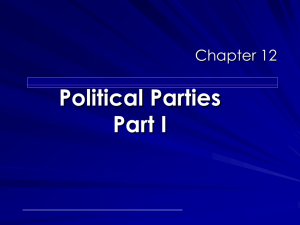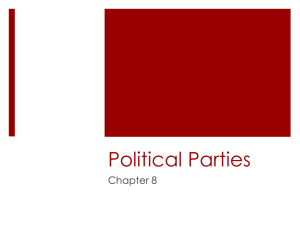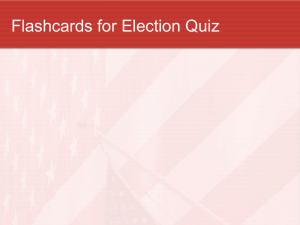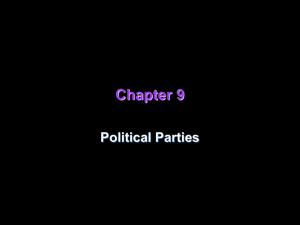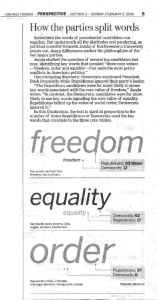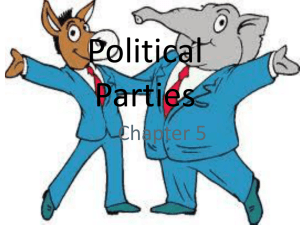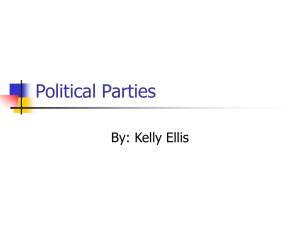Janda Chapter 8 Political Parties Mr. Cook's Notes and Points from
advertisement
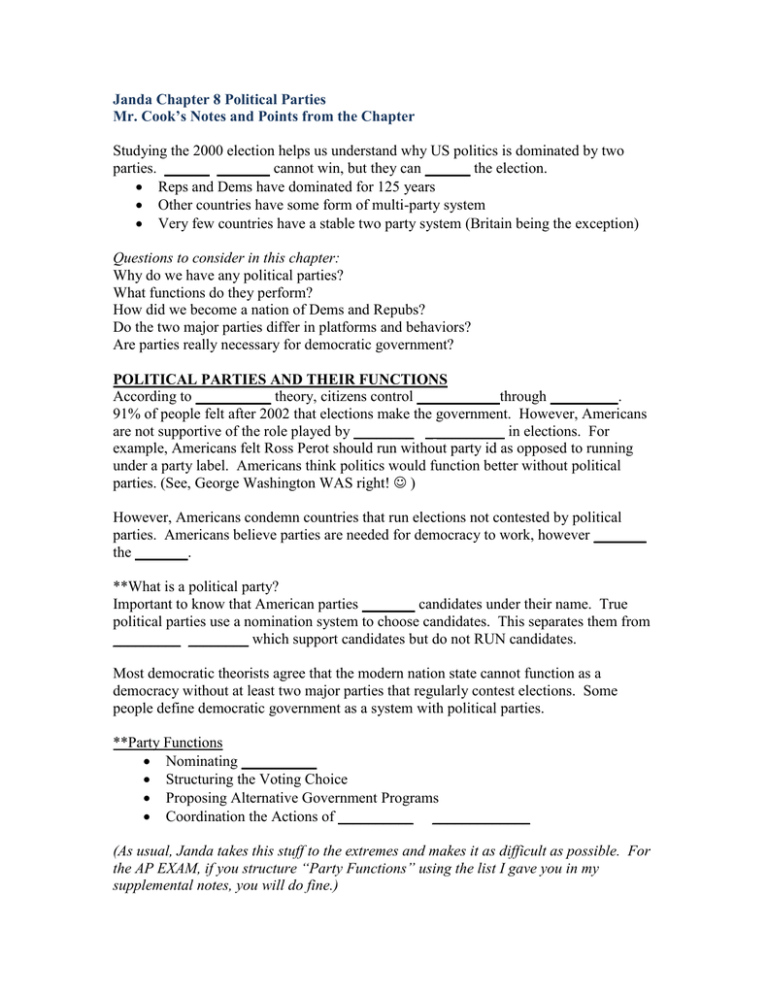
Janda Chapter 8 Political Parties Mr. Cook’s Notes and Points from the Chapter Studying the 2000 election helps us understand why US politics is dominated by two parties. _____ _______ cannot win, but they can ______ the election. Reps and Dems have dominated for 125 years Other countries have some form of multi-party system Very few countries have a stable two party system (Britain being the exception) Questions to consider in this chapter: Why do we have any political parties? What functions do they perform? How did we become a nation of Dems and Repubs? Do the two major parties differ in platforms and behaviors? Are parties really necessary for democratic government? POLITICAL PARTIES AND THEIR FUNCTIONS According to __________ theory, citizens control __________ through _________. 91% of people felt after 2002 that elections make the government. However, Americans are not supportive of the role played by ________ _ _________ in elections. For example, Americans felt Ross Perot should run without party id as opposed to running under a party label. Americans think politics would function better without political parties. (See, George Washington WAS right! ) However, Americans condemn countries that run elections not contested by political parties. Americans believe parties are needed for democracy to work, however _______ the _______. **What is a political party? Important to know that American parties _______ candidates under their name. True political parties use a nomination system to choose candidates. This separates them from _________ ________ which support candidates but do not RUN candidates. Most democratic theorists agree that the modern nation state cannot function as a democracy without at least two major parties that regularly contest elections. Some people define democratic government as a system with political parties. **Party Functions Nominating __________ Structuring the Voting Choice Proposing Alternative Government Programs Coordination the Actions of __________ _____________ (As usual, Janda takes this stuff to the extremes and makes it as difficult as possible. For the AP EXAM, if you structure “Party Functions” using the list I gave you in my supplemental notes, you will do fine.) NOMINATING FUNCTION Could anyone hold office? Should we have “lotteries?” Most people say no and that holding office requires certain skills and knowledge. Without political parties, voters would face a long list of potentially self-nominated candidates. How would we vote for this long list? Probably through knowing these people personally, celebrity status, or name recognition. (On a side note: I argue we kind of do that already as it is WITH parties) Parties help ensure a minimum level of quality among candidates. STRUCTURING THE VOTING CHOICE Reducing the number of candidates on the ballot to those with a realistic chance of winning. Their support helps keep nonparty candidates from running. PROPOSING ALTERNATIVE GOVERNMENT PROGRAMS Parties help the voter know what government policies the candidate will pursue once in office. Even though there may be slight differences within the same party, most candidates under a party banner are in the same boat. COORDINATING THE ACTIONS OF GOVERNMENT OFFICIALS We have three branches of government in our nation responsible for policy. These three branches do not have to coordinate with each other. This function of the political party does this for us. A HISTORY OF US POLITICAL PARTY POLITICS Several generations have supported the two major parties in America, they are historic. The Democrats have a claim as possibly the oldest party in existence. **The Pre-Party Period The Constitution makes no mention of _______. It’s common to refer to these early groups as ___________. These factions were considered dangerous and were addressed in Federalist #10. Factions existed under British rule in America as well. (Tories and Whigs) Backing the Constitution or not led to Feds and Anti-Feds. These early groups could not be called “parties” because they did not sponsor candidates for election. These Federalists: favored a stronger central government; led by __________ Anti-Feds became known as the Republicans to distance themselves from the aristocratic ways of Hamilton’s party. Feds began calling them DEMOCRATIC-REPUBLICANS in hopes of making them sound like a party of disorder and tie them to the radical democrats in _______. They supported a less powerful, __________ national government; led by ___________ Elections were vastly different back them from today’s elections. Elections back then were a much more elitist model, small groups of like-minded individuals meeting in secrecy. **The First Party System: Federalists and Democratic Republicans George Washington spoke out against the “baneful effects” of party because of the political split within his own administration. The Presidential election of 1796 led to competing parties and a Prez and VP of different parties. The Constitution did not anticipate such an occurrence. The nominating function became more clear in the election of 1800. This was the first true party contest for president. Led to a TIE in the electoral college. This election and the 1796 election led to the 12th amendment. 1800 was the beginning of the end for the Federalists who lost 4 elections in a row, gone by 1820. During this time, there was a lack of party competition and the period was dubbed the “Era of Good Feelings” because of this. the party neglected their function of nominating and this led to an “issue” in 1824: three party candidates all vying for the job. In addition to the House choosing the president in the election of 1824, it was noteworthy because of the growing nation. Voting was expanding, many states were allowing citizens to choose ________ rather than _________. **The Second Party System: Democrats and Whigs The Jacksonians were supported by common people in the South and West and called themselves simply __________, election of 1828 marked the beginning of today’s Democrat party. 1828 was the first mass election in American History. Parties needed to campaign for votes as well. _________ playing a larger role. This led to nominating conventions rather than the old elitist caucus system. Conventions were actually started by The _____________ Party in 1831, they were the first to challenge the two major parties. National Republican (not the Repubs of today) led by John Q. Adams wanted to bring back the Federlaist ideals of a strong national government. Lost to Jackson. Ironically, Jackson began acting like a National Republican and asserting strong national power over states. “King Andrew” haters formed the WHIG PARTY in reference to the old British reference to opposition to the king. Slavery and sectionalism destroyed the Whigs, no candidate in the 1856 election. **The Current Party System: Democrats and Republicans Early 1850’s, anti-slavery forces along with Whigs and anti-slavery Democrats organize to form a new party, the Republicans, to stop expansion of slavery into Kansas and Nebraska territories. Republican party of today. First election in 1856, Fremont, Lincoln in 1860. Democrats splitting over the issue of ________. 1860 is considered the first ________ election of three, that is, a sharp change in party loyalty among voters. This change is called an electoral realignment. 1880-1920 – 11 former Confederate states “Solid South” never voted Republican 1920 Republican Harding carried Tennessee 1928 Repubs took 5 solid southern states (Dems ran their first catholic) 1952 Republican Eisenhower breaks the Democrat dominance in the South, 90 years after the Civil War! **Eras of Party Dominance since the Civil War Two Party system: voters so loyal to one of the big two parties that other candidates have little shot at victory. Very few third party candidates have won election to the House of Reps, even fewer the Senate and NONE the White House. Majority Party in this area (Greene Co.) is the __________party– when most of the voters in an area support one of the two major parties over the other….Minority Party around here would be defined as the __________. Three Periods have characterized the balance between the two major parties at the national level: 1860-1894 1896-1930 1932-Present (remember this book was copyrighted in 2005; are we in the midst of a shift from 2008 to today?????) A ROUGH BALANCE 1860-1894 GOP (Grand Old Party, Republicans) won 8 of 10 presidential elections because of running old Civil War heroes. HOWEVER, the House of Reps is a better judge of party dominance and in this period and each party controlled it 9 times. A REPUBLICAN MAJORITY 1896-1930 Second critical election in 1896 transformed Republicans into the true majority party. McKinley runs as a Republican against the Democrat Cleveland (during which time the US was in a depression). McKinley campaigned from his own home on the platform of high tariffs and money tied to gold standards. Bryan ran as a Democrat. (also the Populist nominee) Populist fable “The Wonderful Wizard of Oz” – political fable which said leaders disguise themselves. Americans found the Democrats to be radical and overwhelmingly voted Republican. National politics dominated by the GOP, President, House of Reps and the Senate until the Great Depression. Only break in the GOP dominance was when they split in because of Teddy Roosevelt’s stint as a third party candidate (most successful ever!) A DEMOCRATIC MAJORITY: 1932 to PRESENT FDR ended the Republican domination in 1932. Campaign related to labor, middle class liberals, new European ethnic voters, urban workers in the north, southern Democrats, Catholics, Jews all formed “Roosevelt Coalition.” Few black voters stayed loyal to the Republicans (party of Lincoln) House and Senate had Democrat majorities as well. Since FDR, a few exceptions, but the Dems have mostly controlled Congress. 1994 was the first time the GOP took Congress in 40 years. Dems have not done as well during this time in the White House. 1948-2004 Dems have only won 6 elections (Add Obama to that number in 2008) Worth noting that the North-South coalition of Democrats has completely crumbled. Are we in a period of electoral dealignment? Party loyalties are less important to voters? The American Two-Party System Special contributions of minor, or third, parties in America. **Minor Parties in America Most minor parties in America have been one of four types: ______ Parties Farmer _____ Parties Parties of __________ ____________ Single-Issue Parties (AGAIN, Janda takes this stuff to the extremes and makes it as difficult as possible. For the AP EXAM, if you organize “types of minor parties” using the info I gave you in my supplemental notes, you will do fine.) BOLTER PARTIES – (Splintered from a major party) Teddy Roosevelt and George Wallace most prominent, but never effected the outcome of an election. FARMER-LABOR PARTIES (comparable to Economic Protest from my notes) Farmers and urban workers not getting their share of society’s wealth. Populists (1892) is a prime example. PARTIES OF IDEOLOGICAL PROTEST – go further than the Famer parties…they criticize the establishment. Socialists have been the most successful (1912). Libertarians as well, who favor freedom over order and equality. Green Party in 1996 and 2000, government intervention to protect the environment. SINGLE –ISSUE PARTIES – promote one principle. Anti-Masonic Parties in the 1820’s and 1830’s opposed secret societies. Free Soil Party – anti-slavery. Prohibition Party is described as the most durable single issue party, in 2004 this party took other conservative stances on issues beyond the original intent of the party, abolishing alcohol. Third parties operate on the periphery of the 2 party system. Third parties usually offer voters a platform to express their discontent with the stances of the two major parties. Ross Perot’s REFORM PARTY did not adhere to any of the four types of minor parties. (I disagree with Janda, I can see qualities of the four types in the Reform Party, Perot was strong individual and WAS a Republican at one point ( I believe) this is a splinter quality. It was also a borderline economic protest party. Anyhow……) Third Parties have not fared well in _________ historically. Republicans were originally a single issue party and came in second place in 1856, this exception to the rule probably fuels current third parties today. Third Parties do well as _______ ________. Major parties have adopted some of their policies: women voting, graduated income tax, and direct election of senators. Most importantly, Third Parties serve as _______ ______. Allow voters a choice to show their discontent with the two major parties. **Why a Two-Party System? The two most convincing answers to this question lie in our country’s electoral system and our process of political socialization. Single Member Districts – we elect one representative to represent a district. Majority Representation vs. proportional representation – The Proportional system tends to perpetuate a multi-party system as in the Netherlands, Denmark, and Israel whereas our system forces interest groups to work within two major parties. The rules of our system explain why only two parties tend to form. But why do the SAME two parties form in every state? The Presidential election is key to the answer to this question. Candidates try to win votes under the major party labels in all 50 states, this tends to allow “uncomfortable alliances” to work together to win such a big prize. We have a two party system, but it has not always been the same two parties. Today though, Dems and Repubs have a stranglehold on the system because they have persisted for a long time at this point. It is difficult for anyone else to break in at this point. **The Federal Basis of the Party System We tend to ignore other races and only focus on the ___________. This distorts the process. Parties do well in other races in other states and this leads to runs into the next contest. **Party Identification in America One of the most important concepts in political science. Signifies a voter’s psychological attachment to a party, this is not the same thing as voting for a party in an election. Voting is a behavior; identification is a state of mind. Self-Identified Repubs, Dems, and Independent: # of Repubs and Dems combined far exceeds independents every year # of Dems consistently outnumber Repubs # of Dems has shrunk over time, to the benefit of both Repubs and Independents, and the three groups are now almost equal in size. Party Ideology and Organization George Wallace said, “there isn’t a dime’s worth difference between the Dems and the Repubs.” Will Rogers said, “I am not a member of any organized political party – I am a Democrat”. Janda believes Wallace was wrong (I disagree) and Rogers was correct. **Differences in Party Ideology Spending – __________ spend more on government programs than ________., for example social programs. However Repubs have spent more on defense. Party Voters vs. Party Activists – few voters think of politics in __________ yet __________ do. ________, Platforms: Freedom, Order, and Equality – Platforms mean a lot to party delegates to conventions as well as to their interest groups. Republicans in 2000 mentioned moral or morality nine times; Democrats were big on equal and quality which were mentioned 12 times. Different but Similar – Very different ideologies, but similar when you compare them to parties in other countries. Specifically, both support capitalism, both reject government ownership of the means of production. Other countries have socialist and anti-socialist views resulting in greater ideological differences. **National Party Organization Democrats are an unorganized party. Repubs not so much since the 1970’s. KEEP IN MIND: Parties parallel the federal system, there are national level organizations as well as state level. Four main organizational components of the parties at the national level: National ____________ National ____________ Congressional Party Conferences Congressional Campaign Committees It is tempting to think of the national party chairperson at the top of a hierarchical chart, but this would be wrong! **State and Local Organizations At one time, powerful state and city organizations controlled the parties. Taminy Hall in NYC (Gangs of New York ) and Cook County Chicago were party machines. Today money flows from the __________ to the ______ level organizations. **Decentralized but Growing Stronger American political parties are among the most decentralized in the world. Not even the president can count on support from his/her party. This absence of decentralized power is the most distinguishing characteristic of the American parties. There is evidence of a resurgence. Globalization of the parties is occurring. However, parties have been so weak, that positive trends have not altered the basic character. The Model of Responsible Party Government The Majoritarian Model of Democracy says parties are essential to making government responsive to public opinion. The ideal role of parties in the MMofD has been formalized into four principles of Responsible Party Government: Parties should present clear and coherent programs to voters Voters should choose candidates on the basis of party programs Winning Party should carry out its program once in office. Voters should hold the governing party responsible at the next election for executing its program

